| Listing 1 - 10 of 34 | << page >> |
Sort by
|
Book
Year: 1995 Publisher: Paris : Le Cherche-Midi,
Abstract | Keywords | Export | Availability | Bookmark
 Loading...
Loading...Choose an application
- Reference Manager
- EndNote
- RefWorks (Direct export to RefWorks)
Book
ISBN: 9004665080 Year: 1995 Publisher: Leiden : BRILL,
Abstract | Keywords | Export | Availability | Bookmark
 Loading...
Loading...Choose an application
- Reference Manager
- EndNote
- RefWorks (Direct export to RefWorks)
Recent estimates by The World Health Organisation and The World Bank indicate that throughout the world each and every year more than 800,000 persons die as a consequence of suicide. This means that the death toll of suicide equals and in many countries even exceeds that of road traffic accidents. In addition to the number of suicidal deaths, at least ten times as many persons make non-fatal attempts to take their lives or harm themselves, often seriously enough to require medical attention and not infrequently resulting in irreversible disability. But still these figures inadequately describe the magnitude of human loss and suffering caused by suicide. If one assumes that for every suicidal death there are at least five persons whose lives are profoundly and often for many years affected by the event -emotionally, socially and economically-, by the event, then each year millions of survivor-victims are added to the tens of millions already 'out there'. Hence, suicide is an ever-recurring catastrophe of the first degree. It is not a phenomenon that first and foremost forms a dubious privilege of the so-called highly developed countries. Suicide also occurs in the developing countries and there is more than suggestive evidence that in several of these countries the suicide rate equals or even surpasses the highest national rates shown by offical statistics. It follows that suicide is an extremely important public health problem. It is, however, a problem that is painfully neglected. Throughout the world, resources devoted to the prevention of suicide are only a tiny fraction of those devoted to the prevention of comparable problems, such as road traffic accidents, or to problems of lesser magnitude, at least in the industrialized countries, such as HIV-infection and Aids. This volume, produced under the supervision and auspices of the World Health Organization, brings together for the first time information on epidemiological, clinical and preventive intervention aspects regarding suicide that have global significance and applicability. After a detailed description of the epidemiology of suicide and suicidal behaviour on an international scale, a large part of the book is devoted to the 'how-to's' of developing and organizing suicide prevention programs and services in different national and cultural settings, both at clinical and community level. In addition, a wealth of practical information for health care workers and volunteers is provided on how to evaluate and deal with acute suicide risk. Examples of successful preventive intervention programs and projects, from the developed as well as the developing world, are provided. Legal and ethical problems involved in suicide prevention are also discussed. Finally, both cultural and biological aspects of suicidal behaviour, as well as their clinical-practice relevance, are examined.
Suicide --- Prevention.
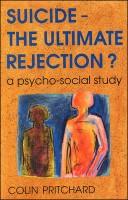
ISBN: 0335190332 Year: 1995 Publisher: Buckingham Philadelphia Open University Press
Abstract | Keywords | Export | Availability | Bookmark
 Loading...
Loading...Choose an application
- Reference Manager
- EndNote
- RefWorks (Direct export to RefWorks)

ISBN: 0335190324 Year: 1995 Publisher: Buckingham Open university press
Abstract | Keywords | Export | Availability | Bookmark
 Loading...
Loading...Choose an application
- Reference Manager
- EndNote
- RefWorks (Direct export to RefWorks)
Suicide --- Suicide victims --- Suicide --- Suicide --- Suicide --- Family relationships --- Prevention --- Sociological aspects --- Statistics
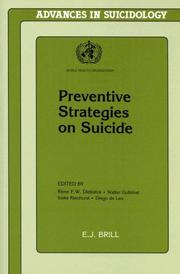
ISBN: 9004103392 Year: 1995 Volume: 2 Publisher: Leiden ; New York E.J. Brill
Abstract | Keywords | Export | Availability | Bookmark
 Loading...
Loading...Choose an application
- Reference Manager
- EndNote
- RefWorks (Direct export to RefWorks)
Suicidal behavior --- Suicide --- Prevention of suicide --- Suicide prevention --- Treatment --- Prevention
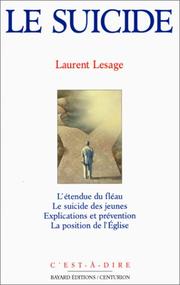
ISBN: 2227362421 9782227362420 Year: 1995 Volume: *1 Publisher: Paris Bayard Éditions/Centurion
Abstract | Keywords | Export | Availability | Bookmark
 Loading...
Loading...Choose an application
- Reference Manager
- EndNote
- RefWorks (Direct export to RefWorks)
Killing oneself --- Self-killing --- Slachtoffers van zelfmoord --- Suicide --- Suicide victims --- Suicide--Victimes --- Suicides --- Victimes du suicide --- Victims of suicide --- Zelfdoding --- Zelfmoord --- Zelfmoord--Slachtoffers --- Suicide. --- Prevention

ISBN: 0815320310 Year: 1995 Volume: 4 1033 Publisher: New York : Garland,
Abstract | Keywords | Export | Availability | Bookmark
 Loading...
Loading...Choose an application
- Reference Manager
- EndNote
- RefWorks (Direct export to RefWorks)
Suicide --- Suicide --- Moral and ethical aspects --- Aspect moral
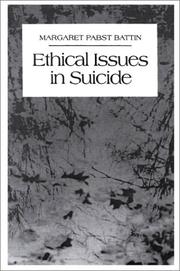
ISBN: 0133046680 Year: 1995 Publisher: Englewood Cliffs (N.J.): Prentice Hall
Abstract | Keywords | Export | Availability | Bookmark
 Loading...
Loading...Choose an application
- Reference Manager
- EndNote
- RefWorks (Direct export to RefWorks)
Suicide --- Suicide --- Moral and ethical aspects --- Religious aspects
Dissertation
Abstract | Keywords | Export | Availability | Bookmark
 Loading...
Loading...Choose an application
- Reference Manager
- EndNote
- RefWorks (Direct export to RefWorks)
penologie --- prisons --- suicide --- prevention --- penologie --- prisons --- suicide --- prevention
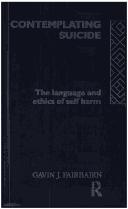
ISBN: 1134845073 1134845081 0203298985 1280066881 0203426371 9780203426371 0415106052 0415106060 9786610066889 6610066884 9780415106054 0415106052 9780415106061 0415106060 9781134845033 9781134845071 9781134845088 9780203298985 9781280066887 Year: 1995 Publisher: London New York Routledge
Abstract | Keywords | Export | Availability | Bookmark
 Loading...
Loading...Choose an application
- Reference Manager
- EndNote
- RefWorks (Direct export to RefWorks)
Suicide is devastating. It is an assault on our ideas of what living is about. In Contemplating Suicide Gavin Fairbairn takes fresh look at suicidal self harm. His view is distinctive in not emphasising external facts: the presence or absence of a corpse, along with evidence that the person who has become a corpse, intended to do so. It emphasises the intentions that the person had in acting, rather than the consequences that follow from those actions. Much of the book is devoted to an attempt to construct a natural history of suicidal self harm and to examine some of the ethical issues that it raises. Fairbairn sets his philosophical reflections against a background of practical experience in the caring professions and uses a storytelling approach in offering a critique of the current language of self harm along with some new ways of thinking. Among other things he offers cogent reasons for abandoning the mindless use of terms such as attempted suicide and parasuicide , and introduces a number of new terms including cosmic roulette , which he uses to describe a family of human acts in which people gamble with their lives. By elaborating a richer model of suicidal self harm than most philosophers and most practitioners of caring professions currently inhabit, Fairbairn has contributed to the development of understanding in this area. Among other things a richer model and vocabulary may reduce the likelihood that those who come into contact with suicidal self harm, will believe that familiarity with the physical facts of the matter - the actions of the suicider and the presence or absence of a corpse - is always sufficient to justify a definite conclusion about the nature of the self harming act.
Suicide --- Suicidal behavior. --- Attempted suicide --- Suicide, Attempted --- Suicide attempts --- Unsuccessful attempted suicide --- Unsuccessful suicide attempts --- Self-destructive behavior --- Parasuicide --- Moral and ethical aspects. --- Suicidal behavior --- Moral and ethical aspects --- Suicide - Moral and ethical aspects
| Listing 1 - 10 of 34 | << page >> |
Sort by
|

 Search
Search Feedback
Feedback About UniCat
About UniCat  Help
Help News
News